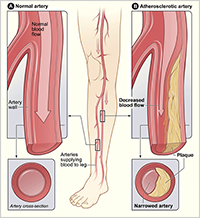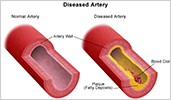Compression Therapy
What is Arterial Disease?
 Arterial Disease is a common circulatory problem in which narrowed arteries reduce blood flow to the limbs. When a person develops Arterial Disease, also known as Peripheral Artery Disease (PAD), they do not receive enough blood flow to keep up with demand. Arterial Disease also causes plaque to build up in the arteries that carry blood to the head, organs, and limbs. Over time, the plaque can harden and narrow the arteries and limit the flow of oxygen-rich blood to the organs and other parts of the body. Arterial Disease usually affects the arteries in the legs, but it can also affect the arteries that carry blood from the heart to the head, arms, kidneys and stomach.
Arterial Disease is a common circulatory problem in which narrowed arteries reduce blood flow to the limbs. When a person develops Arterial Disease, also known as Peripheral Artery Disease (PAD), they do not receive enough blood flow to keep up with demand. Arterial Disease also causes plaque to build up in the arteries that carry blood to the head, organs, and limbs. Over time, the plaque can harden and narrow the arteries and limit the flow of oxygen-rich blood to the organs and other parts of the body. Arterial Disease usually affects the arteries in the legs, but it can also affect the arteries that carry blood from the heart to the head, arms, kidneys and stomach.
When peripheral vascular disease (PVD) occurs in the arteries outside the heart, it may be referred to as peripheral arterial disease (PAD). However, the terms "peripheral vascular disease" and "peripheral arterial disease" are often used interchangeably. It's frequently found in people with coronary artery disease, because atherosclerosis, which causes coronary artery disease, is a widespread disease of the arteries.
Symptoms of Arterial Disease
One of the symptoms of Arterial Disease is pain and numbness, which is due to blocked blood flow. It can also raise the risk of getting an infection in the affected limbs and because of this the body may have a hard time fighting the infection. In some severe cases, this blocked blood flow can cause gangrene (tissue death) and in more serious cases, can lead to leg amputation.
Causes of Arterial Disease
 One of the main risk factors of Peripheral Arterial Disease is smoking. Smoking increases the risk of Arterial Disease increases by up to four times. Other factors, such as age and having certain diseases or conditions, also increase the risk of Arterial Disease.
One of the main risk factors of Peripheral Arterial Disease is smoking. Smoking increases the risk of Arterial Disease increases by up to four times. Other factors, such as age and having certain diseases or conditions, also increase the risk of Arterial Disease.
Arterial Disease is linked strongly with diabetes. Many diabetic patients have poor blood flow and are at high risk of developing “diabetic foot,” a complication in which the foot develops non-healing ulcers or infections due to lack of blood flow and pooling of the blood. If not treated properly, this condition can lead to amputation.
A Solution to Arterial Disease
Surgery, medication, and the use of arterial compression pumps that help improve blood circulation are all recommended as possible treatments.




